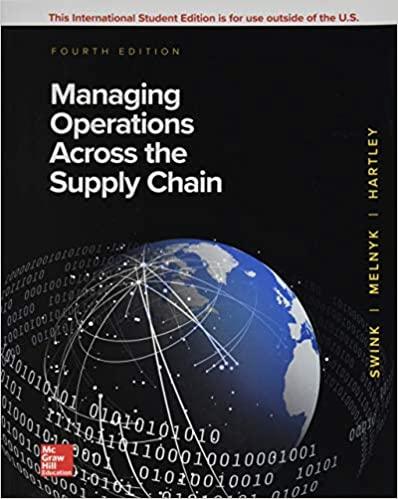Question
Hello I need your help in answering the following questions in detail and in writing an evidence-based analysis of the issue/ situation using the case
Hello I need your help in answering the following questions in detail and in writing an evidence-based analysis of the issue/ situation using the case study below:
Case study link:https://hbsp.harvard.edu/product/W20780-PDF-ENG
https://www.thecasecentre.org/products/view?id=172256
Analysis of Issue Using Research Evidence (Academic Articles) that are:
1. "https://pdfs.semanticscholar.org/b007/67733def23284a06177a26cc60132902c98d.pdf
Summary: As said by Budianto and Susanto (2020), optimum levels of monitoring of a team lead to improving the resultant psychological safety of team members and the learning outcomes of the team. To reach such a conclusion, the researchers used structural equation modeling to analyze data, which had been collected through questionnaires carried out in various teams within business organizations. They found that a high resultant level of team members' psychological safety positively correlated with an optimum level of team monitoring. Psychologically safe teams were likelier to engage in open communication or inclusive and collaborative learning, and led to improved performance in the teams. What should be considered by managers is a balanced type of monitoringnot being overly controlling but providing enough oversight to make team members feel secure enough to release their thoughts and concerns."
2. "https://www.ncbi.nlm.nih.gov/pmc/articles/PMC8936758/
Summary: Being able to manage psychological safety during the process of debriefings effectively facilitates better team communication and supports better learning outcomes. Controlled experiments in virtual environments have been carried out by Kolbe et al., (2020). In these experiments, the effect of specific debriefing strategies on psychological safety and team performance was measured. Findings suggest that debriefing strategies actively maintaining or repairing psychological safety in team debriefings have a relatively significant positive impact on the communication and learning of teams. Several specific debriefing strategies should be used by managers to actively maintain and repair psychological safety within teams in debriefings; specifically, this should include an inclusive environment where team members feel valued and respected."
3. "https://www.researchgate.net/profile/Lucia-Rodriguez-Aceves/publication/344941463_Enabling_knowledge_sharing_through_psychological_safety_in_inter-organisational_arrangements/links/5f99ca9b92851c14bcf0764a/Enabling-knowledge-sharing-through-psychological-safety-in-inter-organisational-arrangements.pdf
Summary: psychological safety is a psychological state that helps facilitate knowledge sharing across organizational boundaries. Research by Rivera et al. (2021) followed an approach where research mixed both a qualitative and quantitative design; thus, they tied up questionnaires with individual employee interviews within various organizations undertaking inter-organizational collaborations. The analysis has been done through a thematic analysis complemented by regression analysis. The results evidenced that, indeed, psychological safety plays a central role as an enabler for knowledge transfer across organizational borders. By feeling psychologically safe, employees became more willing to share critical information to cooperate effectively. They have to be more concerned with psychologically safe environments that promote greater knowledge sharing and collaboration within inter-organizational project settings."
4. "https://openpsychologyjournal.com/VOLUME/16/ELOCATOR/e187435012307090/FULLTEXT/
Summary: Psychological safety is an essential factor that affects team learning, efficacy, and productivity. Patil et al. (2023) examined the influence of psychological safety on team learning and performance. A survey of experience was carried out across organizational teams to quantify psychological safety using qualitative measures, and team performance outcomes were also quantified using quantitative measures. Multiple regression was then conducted to develop findings from thematic analysis. Their results show that psychological safety has a significant positive relationship with learning and productivity at the individual and group levels. The teams that reported higher psychological safety also perceived more cohesion, willingness to take risks, and performance in the team. This implies that psychological safety as a culture needs to be invested in by the organization to improve the dynamics of the teams and overall effectiveness. This may be developed by subjecting the leaders to training toward the advocacy of open communications and support of their teams."
5. "https://doi.org/10.1108/K-04-2020-0229
Summary: The research paper " The prisoner's dilemma in the workplace: how cooperative behavior of managers influence organizational performance and stress." Spurn et al. (2022) studies the connection between cooperative behavior from managers and how it can in turn affect organizational performance and stress levels. The main hypothesis of the paper is that consistently cooperative managers enhance overall performance and reduce employee stress. In order to test this, the researchers developed a computer simulation to mimic real-life situations using a program called NetLogo which is a "multi-parameter agent-based model is proposed which implements the prisoner's dilemma game approach on a scale-free network (Spurn et al., 2022)" . Major findings in the study found that improving employees' stress resistance would boost their performance, while increasing only the managers' stress resistance does not increase any major outcomes. However, it was found that when managers are cooperative, there is a significant increase in overall organizational performance and noticeable decrease in stress levels, and lower stress resistance in employees. (Spurn et al., 2022). The study suggests that managers that are consistently cooperative in an effort to benefit their team, will lead to more efficient and less stressful work environments for all (Spurn et al., 2022)."
Questions: 1. Based on the evidence from the academic articles above, diagnose what is causing the issues at this organization and explain? 2. Identify the important organizational constraints and explain? 3. Indicate if there are controversies/limitations in the evidence that are relevant to the analysis and explain?
Step by Step Solution
There are 3 Steps involved in it
Step: 1

Get Instant Access to Expert-Tailored Solutions
See step-by-step solutions with expert insights and AI powered tools for academic success
Step: 2

Step: 3

Ace Your Homework with AI
Get the answers you need in no time with our AI-driven, step-by-step assistance
Get Started


